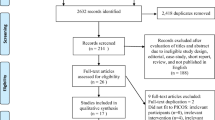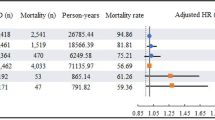Abstract
Inconsistent results regarding the association between statin use and risk of Parkinson’s disease (PD) have been reported. We therefore examined the association between statin use and risk of PD by conducting a detailed meta-analysis of all observational studies published regarding this subject. A literature search in the PubMed database was undertaken through April 2012, looking for observational studies evaluating the association between statin use and risk of PD. Combined relative risk (RR) estimates and 95 % confidence intervals (CIs) were calculated using a random-effects model. Subgroup and sensitivity analyses were also performed. A total of eight (five case–control and three cohort) studies contributed to the analysis. There was heterogeneity and publication bias among the studies. Statin use significantly reduced the risk of PD by 23 % (RR 0.77, 95 % CI 0.64–0.92, p = 0.005). However, long-term statin use did not significantly affect the risk of PD (RR 0.72, 95 % CI 0.45–1.13, p = 0.15). Stratification of studies by age and smoking status significantly affected the final estimate (age-adjusted RR 0.61, 95 % CI 0.42–0.86, p = 0.005; age-not-adjusted RR 0.93, 95 % CI 0.83–1.05, p = 0.23 and smoking-adjusted RR 0.60, 95 % CI 0.42–0.87, p = 0.007; smoking-not-adjusted RR 0.92, 95 % CI 0.82–1.02, p = 0.10). Furthermore, sensitivity analysis confirmed the stability of results. Our meta-analysis supports the hypothesis that statin use reduced the risk of PD. Nevertheless, more randomized clinical trials and observational studies are required to confirm this association with underlying biological mechanisms in the future.




Similar content being viewed by others
References
Lang AE, Lozano AM (1998) Parkinson’s disease. First of two parts. N Engl J Med 339:1044–1053
Schapira AH (2006) Etiology of Parkinson’s disease. Neurology 66:S10–S23
Wirdefeldt K, Adami HO, Cole P, Trichopoulos D, Mandel J (2011) Epidemiology and etiology of Parkinson’s disease: a review of the evidence. Eur J Epidemiol 26:S1–S58
Lamb E (2009) Top 200 drugs of 2008. http://www.pharmacytimes.com/issue/pharmacy/2009/2009-05/RxFocusTop200Drugs-0509. Accessed 2 May 2012
Becker C, Meier CR (2009) Statins and the risk of Parkinson disease: an update on the controversy. Expert Opin Drug Saf 8:261–271
Wood WG, Eckert GP, Igbavboa U, Muller WE (2010) Statins and neuroprotection: a prescription to move the field forward. Ann NY Acad Sci 1199:69–76
Wang Q, Yan J, Chen X, Li J, Yang Y, Weng J, Deng C, Yenari MA (2011) Statins: multiple neuroprotective mechanisms in neurodegenerative diseases. Exp Neurol 230:27–34
Selley ML (2005) Simvastatin prevents 1-methyl-4-phenyl-1,2,3,6-tetrahydropyridine-induced striatal dopamine depletion and protein tyrosine nitration in mice. Brain Res 1037:1–6
Huang X, Chen H, Miller WC, Mailman RB, Woodard JL, Chen PC, Xiang D, Murrow RW, Wang YZ, Poole C (2007) Lower low-density lipoprotein cholesterol levels are associated with Parkinson’s disease. Mov Disord 22:377–381
de Lau LM, Stricker BH, Breteler MM (2007) Serum cholesterol, use of lipid-lowering drugs, and risk of Parkinson disease. Mov Disord 22:1985–1987
Wolozin B, Wang SW, Li NC, Lee A, Lee TA, Kazis LE (2007) Simvastatin is associated with a reduced incidence of dementia and Parkinson’s disease. BMC Med 5:20
Becker C, Jick SS, Meier CR (2008) Use of statins and the risk of Parkinson’s disease: a retrospective case–control study in the UK. Drug Saf 31:399–407
Samii A, Carleton BC, Etminan M (2008) Statin use and the risk of Parkinson disease: a nested case control study. J Clin Neurosci 15:1272–1273
Wahner AD, Bronstein JM, Bordelon YM, Ritz B (2008) Statin use and the risk of Parkinson disease. Neurology 70:1418–1422
Ritz B, Manthripragada AD, Qian L, Schernhammer E, Wermuth L, Olsen J, Friis S (2010) Statin use and Parkinson’s disease in Denmark. Mov Disord 25:1210–1216
Gao X, Simon KC, Schwarzschild MA, Ascherio A (2012) Prospective study of statin use and risk of Parkinson disease. Arch Neurol 69:380–384
The Long-Term Intervention with Pravastatin in Ischaemic Disease (LIPID) Study Group (1998) Prevention of cardiovascular events and death with pravastatin in patients with coronary heart disease and a broad range of initial cholesterol levels. N Engl J Med 339:1349–1357
Downs JR, Clearfield M, Weis S, Whitney E, Shapiro DR, Beere PA, Langendorfer A, Stein EA, Kruyer W, Gotto AM Jr (1998) Primary prevention of acute coronary events with lovastatin in men and women with average cholesterol levels: results of AFCAPS/TexCAPS. Air Force/Texas Coronary Atherosclerosis Prevention Study. JAMA 279:1615–1622
Heart Protection Study Collaborative Group (2002) MRC/BHF Heart Protection Study of cholesterol lowering with simvastatin in 20,536 high-risk individuals: a randomised placebo-controlled trial. Lancet 360:7–22
Simon KC, Chen H, Schwarzschild M, Ascherio A (2007) Hypertension, hypercholesterolemia, diabetes, and risk of Parkinson disease. Neurology 69:1688–1695
Ottawa Hospital Research Institute (2011) The Newcastle-Ottawa Scale (NOS) for assessing the quality of nonrandomised studies in meta-analyses. http://www.ohri.ca/programs/clinical_epidemiology/oxford.asp. Accessed 2 May 2012
Zhang J, Yu KF (1998) What’s the relative risk? A method of correcting the odds ratio in cohort studies of common outcomes. JAMA 280:1690–1691
Begg CB, Mazumdar M (1994) Operating characteristics of a rank correlation test for publication bias. Biometrics 50:1088–1101
Egger M, Davey SG, Schneider M, Minder C (1997) Bias in meta-analysis detected by a simple, graphical test. BMJ 315:629–634
Higgins JP, Thompson SG, Deeks JJ, Altman DG (2003) Measuring inconsistency in meta-analyses. BMJ 327:557–560
Altman DG, Bland JM (2003) Interaction revisited: the difference between two estimates. BMJ 326:219
Stroup DF, Berlin JA, Morton SC, Olkin I, Williamson GD, Rennie D, Moher D, Becker BJ, Sipe TA, Thacker SB (2000) Meta-analysis of observational studies in epidemiology: a proposal for reporting. Meta-analysis Of Observational Studies in Epidemiology (MOOSE) group. JAMA 283:2008–2012
Whitton PS (2007) Inflammation as a causative factor in the aetiology of Parkinson’s disease. Br J Pharmacol 150:963–976
Greenamyre JT, Hastings TG (2004) Biomedicine. Parkinson’s—divergent causes, convergent mechanisms. Science 304:1120–1122
Devaraj S, Chan E, Jialal I (2006) Direct demonstration of an antiinflammatory effect of simvastatin in subjects with the metabolic syndrome. J Clin Endocrinol Metab 91:4489–4496
Resch U, Tatzber F, Budinsky A, Sinzinger H (2006) Reduction of oxidative stress and modulation of autoantibodies against modified low-density lipoprotein after rosuvastatin therapy. Br J Clin Pharmacol 61:262–274
Obata T, Yamanaka Y (2000) Protective effect of fluvastatin, a new inhibitor of 3-hydroxy-3-methylglutaryl coenzyme A reductase, on MPP(+)-induced hydroxyl radical in the rat striatum. Brain Res 860:166–169
Murtola TJ, Tammela TL, Mllttlnen L, Huhtala H, Platz EA, Ala-Opas M, Stenman UH, Auvinen A (2010) Prostate cancer and PSA among statin users in the Finnish Prostate Cancer Screening Trial. Int J Cancer 127:1650–1659
Schachter M (2004) Chemical, pharmacokinetic and pharmacodynamic properties of statins: an update. Fundam Clin Pharmacol 19:117–125
Mason RP, Walter MF, Day CA, Jacob RF (2005) Intermolecular differences of 3-hydroxy-3-methylglutaryl coenzyme A reductase inhibitors contribute to distinct pharmacologic and pleiotropic actions. Am J Cardiol 96:11–23
Acknowledgments
The authors thank Dr. Dimple Kondal, Senior scientist (Biostatistician), Centre for excellence, Public Health Foundation, India for helping with the data analysis.
Conflicts of interest
No potential conflict of interest relevant to this article was reported. No funding was provided for this analysis.
Author information
Authors and Affiliations
Corresponding author
Rights and permissions
About this article
Cite this article
Undela, K., Gudala, K., Malla, S. et al. Statin use and risk of Parkinson’s disease: a meta-analysis of observational studies. J Neurol 260, 158–165 (2013). https://doi.org/10.1007/s00415-012-6606-3
Received:
Revised:
Accepted:
Published:
Issue Date:
DOI: https://doi.org/10.1007/s00415-012-6606-3




